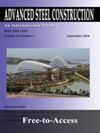Push-out experiments of headed shear studs in group arrangements
IF 1.7
3区 工程技术
Q3 CONSTRUCTION & BUILDING TECHNOLOGY
引用次数: 42
Abstract
Precast concrete slabs connected to the steel beams by headed shear studs arranged in groups may be used in high-rise office buildings to speed up construction process and improve quality by increasing the grade of industrialization. The paper presents experimental research performed on push-out tests at the Faculty of Civil Engineering University in Belgrade. The main goal has been to investigate possible reductions (if any) of shear stiffness and strength of five group arrangements consisting always of four headed shear studs, the shank diameter 16 mm and 100 mm height. A shape of group arrangement and its orientation to the applied load, and distance between the studs were variables considered. Intention was to have as small as possible holes in precast concrete slabs so the distance between studs was lower than minimum required in Eurocode 4 (1). Comparison is made with results obtained on specimen with uniformly distributed shear studs, according to requirements of the standard arrangement (1). Material characteristics were obtained and push-out tests were preformed in procedures that fully comply with Eurocode 4. Experimental results were evaluated according to the design models in Eurocode 4 and available literature, Okada-Yoda-Lebet (2). Recommendations for use of the group arrangements were proposed.群排头剪钉推出试验
预制混凝土板采用成组布置的头剪螺钉与钢梁连接,可用于高层办公建筑,加快施工进度,提高工业化档次,提高质量。本文介绍了在贝尔格莱德土木工程大学进行的推出试验研究。主要目标是研究五组布置的剪切刚度和强度的可能降低(如果有的话),这些布置总是由四个头剪切螺柱组成,柄直径为16毫米,高度为100毫米。考虑了组布置的形状及其对施加载荷的方向,以及螺柱之间的距离。目的是使预制混凝土板上的孔尽可能小,因此螺栓之间的距离低于欧洲规范4(1)的最小要求。根据标准布置(1)的要求,与均匀分布的剪切螺栓试件的结果进行比较。根据欧洲规范4的要求,获得了材料特性并进行了推出试验。根据Eurocode 4中的设计模型和现有文献Okada-Yoda-Lebet(2)对实验结果进行了评估。提出了使用分组布置的建议。
本文章由计算机程序翻译,如有差异,请以英文原文为准。
求助全文
约1分钟内获得全文
求助全文
来源期刊

Advanced Steel Construction
CONSTRUCTION & BUILDING TECHNOLOGY-ENGINEERING, CIVIL
CiteScore
2.60
自引率
29.40%
发文量
0
审稿时长
6 months
期刊介绍:
The International Journal of Advanced Steel Construction provides a platform for the publication and rapid dissemination of original and up-to-date research and technological developments in steel construction, design and analysis. Scope of research papers published in this journal includes but is not limited to theoretical and experimental research on elements, assemblages, systems, material, design philosophy and codification, standards, fabrication, projects of innovative nature and computer techniques. The journal is specifically tailored to channel the exchange of technological know-how between researchers and practitioners. Contributions from all aspects related to the recent developments of advanced steel construction are welcome.
 求助内容:
求助内容: 应助结果提醒方式:
应助结果提醒方式:


